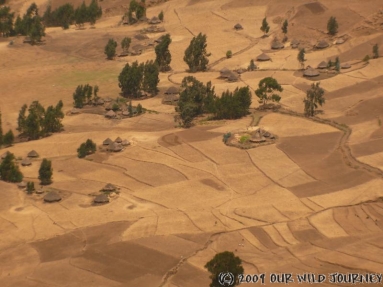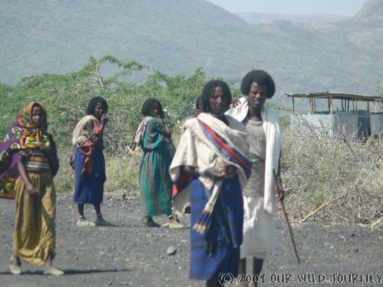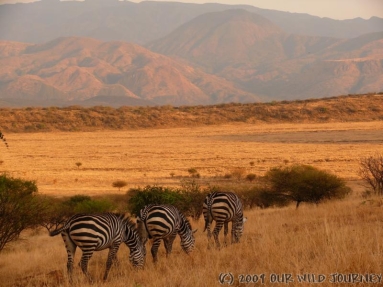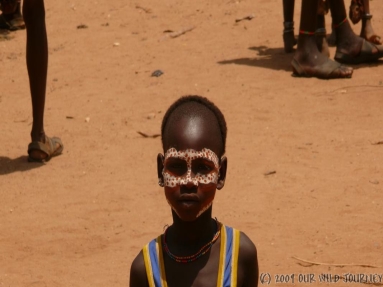Our Wild Journey Travel diary
Main menu:
Ethiopia
![]() ETHIOPIA
ETHIOPIA
We have added a few more sentences and Rene's nearly offroad crash video to the Sudan pages...:o)
Friday 13th February - Thursday, 19th February 2009
...our exit from Sudan was relatively easy and quick and the Ethiopian border isn't really a border - hundreds of people just walk from one side to the other! :o) Within 30 min we had all our stamps and left this horrible little border town of Matama to start our "Ethiopian adventure". No more asphalt, so we drove with 30 kph until the twilight told us to stop for the night - which was only around 30km behind the border. So we just unpacked our tent behind some little village in the bush. The night was quiet, only the next morning for breakfast we had our fist visitors - Ethiopian children. Through field tracks (Ethiopian highways!) we made our way to Debark just before the Simien Mountains, where we the next day loaded a scout and his Kalashnikov into our car (he had to sit on our safe box between the seats) and drove all the way up to this nice National Park. The way was stony and rough, kids were running alongside the car screaming "Money, money!" and even threw stones at us! (Just before we already thought we had mistaken borders and weren't in Ethiopia - it was so quiet!!!) The nature here was just amazing, high mountains, steep escarpments and a spectacular view! We even had the chance to meet a large group of Gelada baboons (which we watched for quite a while!) and the endemic Walya Ibex as well as Klippspringer. Unfortunately, hyena we only heard at night but didn't see. We went till 4277 m to have a nice look on Ethiopia's highest mountain, Ras Dashen (4620) and then went back to the Sankaber Camp to stay there for the night together with other tourists. The next day we slowly descended to Debark again, where it didn't hold us long, so we drove back to Gonder. But also here it was full of begging kids so we just took money from the bank (Dashen bank has Visa ATMs), took a full tank and tried a slow internet connection which did nothing but driving us crazy and left towards Bahir Dar. On the way there we found a turnoff to some hot springs and just arrived after dark. Along the track we saw some warthog family and rabbits. The next morning our Ethiopian tick (a boy who just watched over EVERY of our moves) took us to the hot springs, where we were supposed to share the bathtub with all other Ethiopian villagers. So we better left it at that and continued towards Addis. Just after a few kilometers a sign nearly hit our nose - "Blue Nile Source", which was a 39km dirt track off the main road. On arriving there we found out that it was a religious place, about hundred people sitting around there with a priest, some undressed to get washed by the holy water. Of course, as we have white skin, the priest sent some boy to us to tell us we would need to pay for seeing the source. Of course we did NOT pay and rattled back to the main road. The night we camped somewhere and again, the next morning had spectators for the "European breakfast show"! :o) It's funny and unnerving how these people here just shamelessly watch everything, even the food till down in the stomach! Ach jo! So we just had our coffee and left with empty stomach! :o( But 70km before Addis, luck was on our side and we found quite a lonely place, even with straight cement floor. :o) After all these dirty, stony roads there was enough work on the car (tighten screws) and enough to clean inside etc. We were so surprised not to get hassled by anyone that we decided to stay here overnight.


Friday 20th February - Saturday 28th February
...on Friday morning we found out everything about our planned trips and because of high costs as well as long organization we swapped Ethiopia's most beautiful and exciting region, Erta Ale (a famous, 613m high active volcano with a permanent lava lake in the North East of Ethiopia close to the Eritrean border), for Harar in the East, known for good coffee and friendly hyenas! :o) So we stocked up on some more nice Ethiopian bread and their famous honeywine "Tej", which is actually quite far from nice Czech honeywine. And as we have it written in our homepage, so it is, the 500 km (to our pleasure paved!) to Harar were a real interesting trip with quite wonderful nature (savanna, forests, mountains), little green fields and typical villages and also the locals changed much more, the color and the dresses got different! The tribes changed from the Amhara to Oromo to the Harari and we could notice the change in skin colour as well...faces got darker and hairstyles wilder! :o) We came to Harar still in daylight but the beginning of town didn't really take our breath away. The LP recommended a the Tewodros Hotel, in front of which hyenas rummage around and after checking in we followed another recommendation for a very nice restaurant, the "Hirut". As we didn't really understand the menu we ordered the chef's special and we got served with a big plate full of "injera" (like a big pancake of a sour dough and rubbery consistence which is made from "tef" or "enset", some sort of "false banana") with yummy, spicy meat sauces of goat meat and green salads. Nearly full already they served the second course - grilled goats meat on a clay grill with charcoal! Really yummy stuff! After an Ethiopian coffee we started walking towards the hotel through the darkness, when the owner of the restaurant picked us up and gave us a lift to the hotel. There we looked out of the window, heard some strange noises and really, we saw a group of hyenas checking rubbish bags on the pile of trash behind the hotel! We took a lamp and went outside and behind the corner we met one - Andrea turned back! :o) The hyenas didn't feel disturbed and just walked between the people in town! In front of the police station there were about 14 hyenas and they got along very well with the police men, which gave them a little bit of meat. So we went to them - to the policemen, not the hyenas! :o) Rene wanted to stay with the camera, but Andrea got convinced and tried feeding them herself. (she got better by the minute!) When the meat was gone we went back to sleep. Well, sleep...the hyenas "greeted" us all night! :o( Sunday was weekend and so the markets and shops were quite empty - it gave us time to walk through the old town (like a medina). Here were not so many begging kids (not so many tourists!!!), mostly they wanted us to take photos and the girls wanted to go walking with Andrea "hand in hand" while the boys tried to climb on Rene. :o)
On Monday we left after having had very nice samosas from the cafe. We found a camp just before Awash and had just finished a yummy tin/meal, when we heard the sound of hyenas (we hadn't invited them for dinner!!!) again. We jumped in the car and drove on, took camp close to a town, but at 3 o'clock at night police woke us up, telling us that it's dangerous for us here because there are a lot of uneducated, poor people around who could see our white skin and the car and might aggress us. So with half open eyes we drove into town and slept on the main road where other truckers parked as well. We got up early the next morning and for breakfast drove to a lonesome spot on lake Basaka (it's not in the map), where we watched crocodiles, marabous and other birds. Just before Addis we turned off the main road because we wanted to relax at the hot springs but as usual, it was turned into a hotel complex. Rene talked Andrea into going there and we paid. Hmmm...we had bad, expensive food, feeded families of cute monkeys and took a bath in the hot pool. At night we wanted to avoid another bad experience so we parked in a hotel for 1,20 USD. Yahoo!!! The other 2 days we spent in Addis, visiting the Ethnological Museum, where we learned about Ethiopia's tribes and the huge Merkato, where we got "overrun" by plonkers, who wanted to offer us their services and just don't get the meaning of "NO". After 1 hour we left the market, dissatisfied from all the "made in China" stuff they try to sell to tourists. More interesting, we found some nice little souvenirs on side roads, strolling over "real" markets, where Andrea found a nice coffeepot for a tenth of the Merkato price and Rene found a nice handmade knife. We didn't go into the "Baro Hotel" in the red light area of town, but chose the smaller but nicer "Wanza Hotel" for a better price. One evening we met Honza, a Czech guy who works here in and killed bacteria with some good whiskey, went for dinner with other Czechs from Dubai and Abu Dhabi and talked a lot. In the hotel we met Sudanese, Algerian and an American backpacker. The Africans invited us for dinner - we hope we don't look so hungry and undernourished that everyone invites us for dinner! :o)


Sunday 1st March - Sunday 8th March 2009
On Sunday morning we quickly updated our homepage and after a short visit to pull out info (letter by letter) from the Tourist office we left Addis, but not on the main roads but off the beaten track towards Jimma. And we did well - the road was asphalted, the meadows and fields green and juicy, little round huts with straw roofs on the side and all in all everything looked very clean and tidy. And even people were like this, no one screamed "Faranji", no open hands, no flying stones and all in all peaceful. After 200km we came towards Arba Minch (40 springs) and there the situation changed. Kids on the road and even women were begging, showing us how hungry they were (and not even hiding that they had a big herd of cattle behind them!) It was all quite a big comedy of playing how hungry they were (especially the women 3x Rene's size!) that we already got a little allergic to this area. On Friday morning we went to the headquarters of Nechisar National Park to buy our tickets for 48 hours. Of course, also here we had to pull every word out of the arrogant Officer's nose (where to find what and how to get to all places). The park fees are 0,50 USD for locals and 10 USD for foreigners. We stayed in the park for 2 days and saw quite a few animals: zebras, antelopes, Kudu, warthogs, hartebeest, dikdik, rabbits, hippos and even a 4-5m long crocodile sunning itself on the beach of lake Chamo. Apart from this we also saw cows (wow!) - some farmers just don't respect the boundaries and graze their cattle here. And of course: someone with a Kalashnikov also came to ask for money! :o( (We are really wondering where all these friendly and lovely Ethiopians are that all travellers talk about - or is it maybe only that they don't want to be called racists???) We wanted to see more crocs so we tried to take the track to the crocodile market, a stretch of beach where they are supposed to laze around. This track seemed long forgotten and not used frequently and we clearly underestimated it! Til halfway the track was just like the others, full of stones and clay, but then it changed drastically, very high grasses and dense vegetation. 1km from the shore we couldn't even see the track anymore and all of a sudden our poor bumblebee went "head first" into a deep hole covered under the grass. S**t! So we had to use our winch for the first time! Uff, we were relieved to see our car on all fours again next to the big hole! Rene found some relatively fresh tracks of some big cat and back in the headquarters they surprised us with the info that some lions inhabit and control this area! So we were really lucky not to be someone's lunch! From there we went to see the springs and to have a nice cold bath in one of the 40 springs. After these bad Ethiopian roads and before the even more terrible ones to come (Omo valley) we decided to take a day rest, do washing, clean up car and do some mechanical checks. Then we went for a beer and tried the internet connection, which didn't work due to power failure!
Early the next day we started our way towards the Omo Valley. Til Konso we enjoyed the asphalt, mixed with pieces of dirt track. The locals here wear European fashion (well, from decades ago) and as we wanted to see genuine tribespeople we sort of just shot through this town and went on. Halfway to Woito we met 2 British bikers again, who we had met before on the way to Gonder. They shared our view on Ethiopia and also stated that stones had been thrown at them! :o( From Woito the way wasn't as boring anymore, and once in a while some young ones from the Tsemai tribe looked at us through the bush in their "half naked" dress ups consisting of short skirt and a lot of bracelets and necklaces as well as beadwork around biceps and head. We camped somewhere in the bush, made a fire against hyenas, had food and fell into our sleeping bags. In the morning we continued along dusty, rocky roads to Jinka. When going through this town we were quite disappointed, the Ari tribes here have normal clothes and in this town it is normal for "faranji-foreigners" to pay a different, higher price than locals. When we had a beer in a pub, they told us it's 8 birr and when we wanted to pay we found out they wanted 9 from us! Rip off!!! Of course we only paid 8! :o) The plan to visit Mago National Park and the Mursi, the tribe with the clay plates in the lip we had to cancel due to exorbitantly high costs. To go to the Mursi villages one had to pay entry and on top of this entry to the park (the village lies within the boundaries) plus a guide...so all in all a good 30 USD per person gone! And for every photo taken the Mursi want 5-7 birr!!! Poor Ethiopians who have nothing to eat and no money!!! :o) At the tourist info we met 2 American ladies who had been to the village and told us that they felt like in a zoo! At least some confirmation fpor us, NOT to go there! We left town and looked for a nice camp to wait till the next morning for the big Jinka market.


The market started late morning and was relly big. We were lucky and found 3 Mursi going shopping...after some bargaining we got our photos for not 7-10 birr, but for 2! Yahoo!!! The market was quite usual, vegetables, plastic things, aluminium pots, clothes, assorted seeds and flours but the biggest attraction were a big line of women sitting there with jerrycans full of arragi - for an unbelievably low price! We took 1 litre! Apart from sweet potatoes and pineapple we also took a few pictures of Hamar, Tsemay etc...
After the typical "market confusion" of an African market we left Jinka towards Key Afar and Turmi. On the way Rene had "hard" negotiations with a farmer about a "kalabasse" (bottle pumpkin), which we bought for 5 birr instead of 80-120! :o) Andrea was happy! Through the Bana land we drove on a very beautiful little dirtroad when we crossed paths with a Landcruiser in which we met 2 Hamar and 2 white guys - Clemens from Germany and Jerome from Switzerland. In Dimeka we sat together for a cold beer and the 2 Hamar guys invited us for some meatless injera (fasting time!!!). We talked and they fortunately even invited us to spend the night in their village and drink coffee with them! Happily we said yes! Dambaiti is a small, typical Hamar village somwhere in the bush around Turmi and no tourist has ever touched it! The anthropologist Ivo Strecker came here in the 80s to document the tribe. So we sat around the fire with men and women, talked (or better...listened) and watched the women preparing coffee in a big "kalabasse" - this pumpkin is used for everything - plate, cup, wallet, milk container, bucket etc etc etc. Before drinking the men were worshipping god and pray-singing and spitting coffee in the sky! With big eyes we watched! :o) After that, we had some sorghum sausages and warm milk - very natural food! Photos? We don't have because we didn't want to destroy this honest invitation with touristy behaviour, so we have it all in our head!
The next morning we left early for Turmi, where we wanted to fill up on diesel...we just didn't know that they wanted to overcharge us for more than double the price! Laughing, we left them standing there and drove back to Dimeka where we got diesel for quite an acceptable price! (1USD per litre). From there back to Turmi, where we took a long break in a dry riverbed, chatting with locals. The evening was quiet and we went sleep early.
The next morning was another market day. Through Geltyi, a Hamar, we sold some of our old things to get more money and then went strolling across the famous Turmi market. People here were more genuine, had tribal clothes on and the whole market had a much more down to earth feeling than in Jinka. Rene traded his axe for a spear and we bought a "borkoto" (wooden pillow) for 15 birr! Andrea even got a present from a little boy - a Hamar bracelet. We took a lot of photos of this whole market full of tribespeople before we left for Omorate in the heat of the day...
Often we read how terrible the road to Omorate is, but reality is different - it's better! :o) The 80km we did in 2 hours and we finally arrived in a dusty, godforgotten town inhabited by thin Dasanech people. On the road we got a hole in the tyre which we fixed there. And while Andrea worked on the computer Rene tried his luck in the Omo river, surrounded by approx 100 kids eagerly watching the white man's attempt to fish! Our original plan was to cross the chocolate brown Omo river and cross into Kenya from the Western side but the bridge hasn't been finished for years and the ferry just doesn't work...so we had to give up and forget about Kelem. Maybe better for us, because on the western side of Lake Turkana there are some tribal troubles at the moment between the Turkana and Pokot people (Pokots just love stealing cows! ;o) )


So what about Ethiopia??? Hmmm...so many travellers describe how lovely and friendly Ethiopians are and we must say: We really don't know how they can say that! Everywhere we were only confronted with begging, arrogance and people seeing us like walking ATMs! :o( The landscapes were really impressive but that's about everything good we can say about Ethiopia! We have been thrown stones at, spit at and the car got kicked...it was enough for us! And another big point we don't understand is the long period of development aid which didn't breed nothing but open hands. Ethiopians are not self contained, they just rely on white man giving them what they need and in our eyes all the NGOs did nothing good! Furthermore we really wonder where all the 25 years of financial support went...probably just a big style money laundering, nothing else! Farmers still use medieval plowshares, carry things on their backs and just have nothing, while in Addis all NGOs have brand new cars with the latest equipment etc. We were disappointed about this big country full of cultivated fields, loads of cattle and sheep but everyone seems to be "hungry"! Czll us racists or not, we didn't like the people and are happy NOT to come back! Which is a shame...we think that Ethiopians should be educated more towards appreciation of the white man helping them with tourism, funding and all!
| Driven kilometers / Diesel total | 4.320 km / 580 litre |
| Days of travel | 24 days |
| Diesel price per litre | 7,15 ETB = 0,65 UDS |
| Accomodation | North,south-bushcamp possible , middle-camp aprox. 3 USD |
| Exchange US Dollar / Ethiopian Birr |
1,- USD / 11,03 Birr |
| Entry costs ( visa, car ..) | 20,- USD ( only visa ) |
| Breakdown and punctures | 1 puncture on back wheel |